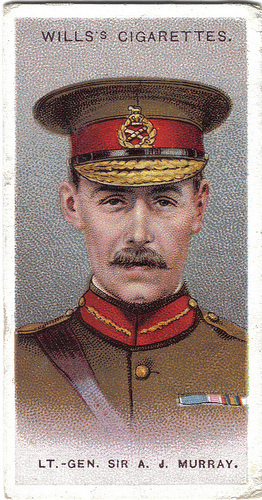|
Harold Grimwade
Major General Harold William Grimwade, (18 May 1869 – 2 January 1949) was an Australian businessman and pharmacist, and a senior officer in the Australian Army. Early life and career Harold William Grimwade was born on 18 May 1869 in St Kilda, Melbourne, the son of Frederick Sheppard Grimwade. Harold was educated at Melbourne Grammar School and the Queen Elizabeth School in Ipswich, Essex, England. He qualified as a pharmacist in London before returning to Australia. He became Felton Grimwade's warehouse manager and a partner in the company in 1893. In this role he displayed a considerable talent for leadership and management of employees. Grimwade joined the Victorian Field Artillery in 1891 and was promoted to lieutenant colonel on 16 May 1910. In August 1914, he became Chief Embarkation Officer for Victoria. First World War Grimwade joined the Australian Imperial Force as a lieutenant colonel on 26 August 1915 to command the 4th Field Artillery Brigade, a new unit form ... [...More Info...] [...Related Items...] OR: [Wikipedia] [Google] [Baidu] |
St Kilda, Victoria
St Kilda is an inner seaside suburb in Melbourne, Victoria (Australia), Victoria, Australia, 6 km (4 miles) south-east of Melbourne's Melbourne City Centre, Central Business District, located within the City of Port Phillip Local government areas of Victoria, local government area. St Kilda recorded a population of 19,490 at the 2021 Australian census, 2021 census. The Traditional Owners of St Kilda are the Yalukit, Yaluk-ut Weelam clan of the Boon wurrung, Boon Wurrung people of the Kulin nation, Kulin Nation. St Kilda was named by Charles La Trobe, then superintendent of the Port Phillip District, after a schooner, ''Lady of St Kilda'', which mooring (watercraft), moored at the main beach in early 1842. Later in the Victorian era, St Kilda became a favoured suburb of Melbourne's elite, and many palatial mansions and grand terraces were constructed along its hills and waterfront. After the turn of the century, the St Kilda foreshore became Melbourne's favoured playground, ... [...More Info...] [...Related Items...] OR: [Wikipedia] [Google] [Baidu] |
Ipswich
Ipswich () is a port town and borough in Suffolk, England, of which it is the county town. The town is located in East Anglia about away from the mouth of the River Orwell and the North Sea. Ipswich is both on the Great Eastern Main Line railway and the A12 road; it is north-east of London, east-southeast of Cambridge and south of Norwich. Ipswich is surrounded by two Areas of Outstanding Natural Beauty (AONB): Suffolk Coast and Heaths and Dedham Vale. Ipswich's modern name is derived from the medieval name ''Gippeswic'', probably taken either from an Anglo-Saxon personal name or from an earlier name given to the Orwell Estuary (although possibly unrelated to the name of the River Gipping). It has also been known as ''Gyppewicus'' and ''Yppswyche''. The town has been continuously occupied since the Saxon period, and is contested to be one of the oldest towns in the United Kingdom.Hills, Catherine"England's Oldest Town" Retrieved 2 August 2015. Ipswich was a settleme ... [...More Info...] [...Related Items...] OR: [Wikipedia] [Google] [Baidu] |
Ammunition Column
An Ammunition Column was a support echelon of a British or Dominion brigade or division during the First World War and consisted of dedicated military vehicles carrying artillery and small arms ammunition for the combatant unit to which the column belonged, generally an Artillery Brigade or a Divisional Artillery. Thus the Ammunition Columns of a division, formed of the brigades of field artillery, carry reserve ammunition for the guns, the machine guns of the infantry and the rifles of all arms. Generally speaking, the Brigade Ammunition Column of the Artillery Brigades furnishes ammunition for its own batteries and for one of the brigades of infantry, and each is supported by a Divisional Artillery. From the start of World War I, as they were 'newly' established, BEF/Dominion 'Infantry’ Divisions came to be assigned a 'Divisional Artillery' of three Field Artillery Brigades and one (Field) Howitzer Brigade, each Brigade having four batteries and a ‘Brigade Ammunition Column ... [...More Info...] [...Related Items...] OR: [Wikipedia] [Google] [Baidu] |
Battle Of Messines (1917)
The Battle of Messines (7–14 June 1917) was an attack by the British Second Army (General Sir Herbert Plumer), on the Western Front, near the village of Messines (now Mesen) in West Flanders, Belgium, during the First World War. The Nivelle Offensive in April and May had failed to achieve its more grandiose aims, had led to the 1917 French Army mutinies, demoralisation of French troops and confounded the Anglo-French strategy for 1917. The attack forced the Germans to move reserves to Flanders from the Arras and Aisne fronts, relieving pressure on the French. The British tactical objective was to capture the German defences on the ridge, which ran from Ploegsteert Wood (Plugstreet to the British) in the south, through Messines and Wytschaete to Mt Sorrel, depriving the German 4th Army (German Empire), 4th Army of the high ground. The ridge gave commanding views of the British defences and back areas of Ypres to the north, from which the British intended to conduct the North ... [...More Info...] [...Related Items...] OR: [Wikipedia] [Google] [Baidu] |
3rd Division (Australia)
The 3rd Division was an infantry division of the Australian Army. Existing during various periods between 1916 and 1991, it is considered the "longest serving Australian Army division". It was first formed during World War I, as an infantry division of the Australian Imperial Force and saw service on the Western Front in France and Belgium. During this time it fought major battles at Messines, Broodseinde Ridge, Passchendaele, Amiens, and the St Quentin Canal. After the war the division was demobilised in 1919 before being re-raised in 1921 as part of the Citizen Forces, based in central Victoria. Throughout the 1920s and 1930s, the division's establishment fluctuated due to the effects of the Great Depression and a general apathy towards military matters. During World War II, the division was mobilised for war in December 1941 and initially undertook defensive duties in Australia before being deployed to New Guinea in 1943 where they took part in the Salamaua–Lae campa ... [...More Info...] [...Related Items...] OR: [Wikipedia] [Google] [Baidu] |
Alexandria
Alexandria ( or ; ar, ٱلْإِسْكَنْدَرِيَّةُ ; grc-gre, Αλεξάνδρεια, Alexándria) is the second largest city in Egypt, and the largest city on the Mediterranean coast. Founded in by Alexander the Great, Alexandria grew rapidly and became a major centre of Hellenic civilisation, eventually replacing Memphis, in present-day Greater Cairo, as Egypt's capital. During the Hellenistic period, it was home to the Lighthouse of Alexandria, which ranked among the Seven Wonders of the Ancient World, as well as the storied Library of Alexandria. Today, the library is reincarnated in the disc-shaped, ultramodern Bibliotheca Alexandrina. Its 15th-century seafront Qaitbay Citadel is now a museum. Called the "Bride of the Mediterranean" by locals, Alexandria is a popular tourist destination and an important industrial centre due to its natural gas and oil pipelines from Suez. The city extends about along the northern coast of Egypt, and is the largest city on t ... [...More Info...] [...Related Items...] OR: [Wikipedia] [Google] [Baidu] |
1st Division (Australia)
The 1st Division is headquartered in Enoggera, a suburb of Brisbane. The division was first formed in 1914 for service during World War I as a part of the Australian Imperial Force (AIF). It was initially part of the Australian and New Zealand Army Corps (ANZAC) and served with that formation during the Gallipoli campaign, before later serving on the Western Front. After the war, the division became a part-time unit based in New South Wales, and during World War II it undertook defensive duties in Australia before being disbanded in 1945. After World War II, the division remained off the Australian Army's order of battle until the 1960s, when it was reformed in New South Wales. In 1965 it adopted a certification role, determining the operational readiness of units deploying to Vietnam. It was re-formed in 1973 as a full division based in Queensland and in the decades that followed it formed the Australian Army's main formation, including both Regular and Reserve personnel. Th ... [...More Info...] [...Related Items...] OR: [Wikipedia] [Google] [Baidu] |
British Expeditionary Force (World War I)
The British Expeditionary Force (BEF) was the six-divisions the British Army sent to the Western Front during the First World War. Planning for a British Expeditionary Force began with the 1906–1912 Haldane reforms of the British Army carried out by the Secretary of State for War Richard Haldane following the Second Boer War (1899–1902). The term ''British Expeditionary Force'' is often used to refer only to the forces present in France prior to the end of the First Battle of Ypres on 22 November 1914. By the end of 1914—after the battles of Mons, Le Cateau, the Aisne and Ypres—the existent BEF had been almost exhausted, although it helped stop the German advance.Chandler (2003), p. 211 An alternative endpoint of the BEF was 26 December 1914, when it was divided into the First and Second Armies (a Third, Fourth and Fifth being created later in the war). "British Expeditionary Force" remained the official name of the British armies in France and Flanders thro ... [...More Info...] [...Related Items...] OR: [Wikipedia] [Google] [Baidu] |
Archibald Murray
General Sir Archibald James Murray, (23 April 1860 – 21 January 1945) was a British Army officer who served in the Second Boer War and the First World War. He was Chief of Staff to the British Expeditionary Force (BEF) in August 1914 but appears to have suffered a physical breakdown in the retreat from Mons, and was required to step down from that position in January 1915. After serving as Deputy Chief of the Imperial General Staff for much of 1915, he was briefly Chief of the Imperial General Staff from September to December 1915. He was subsequently Commander-in-Chief of the Egyptian Expeditionary Force from January 1916 to June 1917, in which role he laid the military foundation for the defeat and destruction of the Ottoman Empire in the Arabian Peninsula and the Levant. Army career Born the son of Charles Murray and Anne Murray (née Graves), and educated at Cheltenham College and the Royal Military College, Sandhurst, Archibald Murray was commissioned into the 27th R ... [...More Info...] [...Related Items...] OR: [Wikipedia] [Google] [Baidu] |
2nd Division (Australia)
The 2nd Division of the Australian Army commands all the Reserve brigades in Australia. These are the 4th in Victoria, the 5th in New South Wales, the 9th in South Australia and Tasmania, the 11th in Queensland, the 13th in Western Australia, and the 8th spread across the country. The division is also responsible for the security of Australia's northern borders through its Regional Force Surveillance Units. The division was first formed in Egypt in July 1915 during World War I as part of the First Australian Imperial Force (1st AIF). The division took part in the Gallipoli campaign, arriving in the latter stages and then traversed to the Western Front in France and Belgium where it had the distinction of taking part in the final ground action fought by Australian troops in the war. After the war ended and the AIF was demobilised, the 2nd Division name was revived and assigned to a Citizens Military Forces (reserve) unit in 1921. During the inter-war years, the division w ... [...More Info...] [...Related Items...] OR: [Wikipedia] [Google] [Baidu] |






